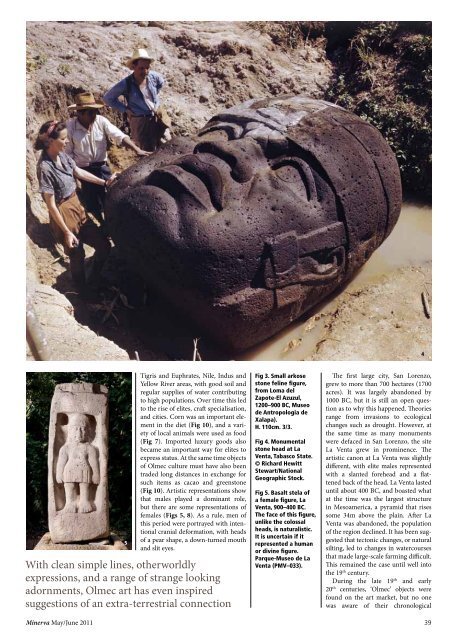Cult of beauty - Minerva
Cult of beauty - Minerva
Cult of beauty - Minerva
Create successful ePaper yourself
Turn your PDF publications into a flip-book with our unique Google optimized e-Paper software.
5<br />
Tigris and Euphrates, Nile, Indus and<br />
Yellow River areas, with good soil and<br />
regular supplies <strong>of</strong> water contributing<br />
to high populations. Over time this led<br />
to the rise <strong>of</strong> elites, craft specialisation,<br />
and cities. Corn was an important element<br />
in the diet (Fig 10), and a variety<br />
<strong>of</strong> local animals were used as food<br />
(Fig 7). Imported luxury goods also<br />
became an important way for elites to<br />
express status. At the same time objects<br />
<strong>of</strong> Olmec culture must have also been<br />
traded long distances in exchange for<br />
such items as cacao and greenstone<br />
(Fig 10). Artistic representations show<br />
that males played a dominant role,<br />
but there are some representations <strong>of</strong><br />
females (Figs 5, 8). As a rule, men <strong>of</strong><br />
this period were portrayed with intentional<br />
cranial deformation, with heads<br />
<strong>of</strong> a pear shape, a down-turned mouth<br />
and slit eyes.<br />
With clean simple lines, otherworldly<br />
expressions, and a range <strong>of</strong> strange looking<br />
adornments, Olmec art has even inspired<br />
suggestions <strong>of</strong> an extra-terrestrial connection<br />
Fig 3. Small arkose<br />
stone feline figure,<br />
from Loma del<br />
Zapote-El Azuzul,<br />
1200–900 BC, Museo<br />
de Antropologia de<br />
Xalapa).<br />
H. 110cm. 3/3.<br />
Fig 4. Monumental<br />
stone head at La<br />
Venta, Tabasco State.<br />
© Richard Hewitt<br />
Stewart/National<br />
Geographic Stock.<br />
Fig 5. Basalt stela <strong>of</strong><br />
a female figure, La<br />
Venta, 900–400 BC.<br />
The face <strong>of</strong> this figure,<br />
unlike the colossal<br />
heads, is naturalistic.<br />
It is uncertain if it<br />
represented a human<br />
or divine figure.<br />
Parque-Museo de La<br />
Venta (PMV–033).<br />
The first large city, San Lorenzo,<br />
grew to more than 700 hectares (1700<br />
acres). It was largely abandoned by<br />
1000 BC, but it is still an open question<br />
as to why this happened. Theories<br />
range from invasions to ecological<br />
changes such as drought. However, at<br />
the same time as many monuments<br />
were defaced in San Lorenzo, the site<br />
La Venta grew in prominence. The<br />
artistic canon at La Venta was slightly<br />
different, with elite males represented<br />
with a slanted forehead and a flattened<br />
back <strong>of</strong> the head. La Venta lasted<br />
until about 400 BC, and boasted what<br />
at the time was the largest structure<br />
in Mesoamerica, a pyramid that rises<br />
some 34m above the plain. After La<br />
Venta was abandoned, the population<br />
<strong>of</strong> the region declined. It has been suggested<br />
that tectonic changes, or natural<br />
silting, led to changes in watercourses<br />
that made large-scale farming difficult.<br />
This remained the case until well into<br />
the 19 th century.<br />
During the late 19 th and early<br />
20 th centuries, ‘Olmec’ objects were<br />
found on the art market, but no one<br />
was aware <strong>of</strong> their chronological<br />
<strong>Minerva</strong> May/June 2011 39<br />
4

















